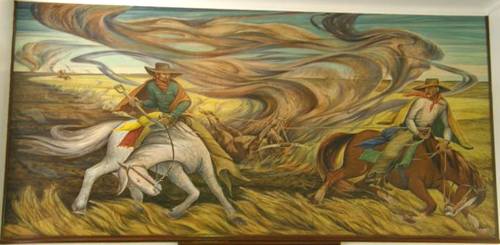Prairie Fire. (original) (raw)
The Rev. C.B. Jernigan spent most of his life trying to save sinners from eternal fire and brimstone, but when he finally got around to writing a memoir he devoted a full chapter to an incident from childhood he remembered as hell on earth � a raging winter prairie fire.
Jernigan, born Sept. 4, 1863, moved with his family to Hunt County after the Civil War. His father practiced medicine, but he also farmed 200 acres, growing cottonand cultivating or tending most of everything else it took to feed his family, from peaches to pork.
In remembering his family�s eight-room house, Jernigan noted it stood �between two deep creeks as a protection from prairie fires that swept the country clean almost every winter.�
The preacher did a good job of describing those fires in his book:
�When winter would set in an the frost killed the grass, often mighty fires would break out, driven before a terrible wind, blowing a gale of 75 miles an hour across these stretches of level prairie land, burning everything in their path. Nothing could live in these flames of destruction�.�
Jernigan remembered prairie fires with flames rising a hundred feet, a racing inferno pushing every living thing � coyotes, rabbits, badgers, wild turkeys and sometimes antelope � in desperate flight. Sometimes whole herds of cattle burned to death.
One winter night screaming woke him up.
�The whole earth seemed to be on fire,� he wrote. �There was a�roaring like�a cyclone, while the earth was trembling beneath the tread of hundreds of wild cattle running and bellowing�.Tall trees along the banks of the creeks were wrapped in flames, as the fire swept down across the prairie.�
Hustled outside, Jernigan saw every able-bodied man in their part of the county slapping the earth with wet tow sacks in an effort to stop the fire. Men and women yelled in the frenzy, but that was different from the screams of people being burned alive.
After the fire passed, Jernigan�s father and others found the charred bodies of a family who had tried to outrun the fire. The father still clutched the body of his child, his dead wife at his side.
�The horrors of that night haunted me for years,� Jernigan continued. �The roar of the fire, the bellowing of the wild herd of cattle, mingled with the screams of these dying people still linger in my ears.�
The fire proved to have been intentionally set. A peddler passing through the county, angered by paltry sales, had exchanged �rough words� with someone before threatening to �burn up the whole county.�
Indeed, someone had seen the traveling salesman tying a big bunch of dried grass to a wire connected to the back of his wagon. Then he ignited it and pulled it along behind him through the dry prairie grass. A vicious north wind did the rest.
Soon after the discovery of the bodies, a posse of more than a hundred men spread out across Hunt County in search of the arsonist. They found the man the next morning in an adjoining county as he sat under a tree eating breakfast.
What happened next is as impressive an example of democracy as the work of the arsonist was horrible. The delibrately set fire sparked a spontaneous combustion of sorts, the creation of an ad-hoc county government.
As Jernigan explained, the incident occurred during the early days of Reconstruction. �No one who had not taken the oath of allegiance to the Federal Government was eligible to be an officer of the law,� he wrote. �Judges and sheriffs were to be appointed by the Federal Government.�
But no one in Hunt County was in a hurry to swear allegiance to the U.S. so soon after the war. Even so, these Hunt County residents were a law-abiding lot. Rather than simply lynch the peddler whose temper had cost three lives, the posse took time to appoint a �sheriff� and elect a �judge.�
The sheriff arrested the suspect while the newly seated judge built a jury pool by ordering all the possee members to write their name on a small piece of paper. The voir dire process consisted of drawing 12 names from a hat. With a further nod to the rule of law, the judge even appointed an attorney for the defendant.
Calling court to order, the judge presided over a trial that went on for an hour. Then, having received its charge, the jury �retired� to begin its deliberation. That lasted only a few minutes before the foreman announced the panel had reached a verdict: Guilty as charged.
Having ridden all night, the possee members were tired and hungry. Rather than calling on the jury to assess punishment, the judge pronounced sentence: �He shall be hanged by his neck until he is dead, dead, dead!�
The sheriff threw a rope over an elm limb, stood the condemned man up on the back of his buggy, tied a blue bandana over his eyes and placed a noose around his neck.
After the arsonist quit kicking, some of the possee members dug a grave under him, cut the rope and covered the hole.
As Jernigan concluded, �It was�crude justice yet far swifter and more sane than the long drawn
December 16, 2010 column
See also Priairie Fires by Mike Cox
Books by Mike Cox - Order Now
 |
|---|

